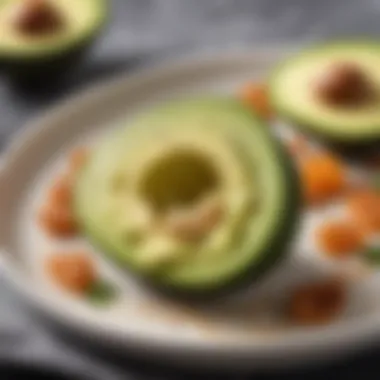Discovering High-Fat, No-Carb Foods: Health Benefits


Intro
In recent years, the nutritional discourse has evolved, illuminating the significant role of high-fat, no-carb foods. This dietary approach is gaining traction as individuals adopt low-carb, high-fat diets, such as ketogenic or carnivore diets. Understanding the nutritional properties and culinary applications of these foods is essential for maximizing their benefits and enhancing meal variety.
The growing interest in maintaining stable blood sugar levels, managing weight, and optimizing mental health has led many to explore foods rich in fats while being free of carbohydrates. This article will offer comprehensive insights into various high-fat, no-carb foods, their biochemical makeup, and their potential health benefits. You will also discover practical ways to integrate these foods into daily meal plans.
Recipe Overview
- Recipe Name: Avocado and Bacon Salad
- Brief Description: This simple yet satisfying dish combines the rich creaminess of ripe avocados with crispy bacon. It is a perfect representation of high-fat, no-carb culinary options. This salad not only provides healthy fats but also offers a burst of flavors, making it a delightful choice for any meal.
Ingredients List
- Main Ingredients:
- Optional Ingredients:
- Ripe avocados
- Cooked bacon
- Olive oil
- Salt
- Pepper
- Chopped herbs, such as chives or parsley
- Cheese, such as feta or mozzarella
- Fresh lemon juice for additional flavor
The combination of avocados and bacon showcases the harmony of high-fat ingredients that can support energy levels while aligning with no-carb preferences.
In the following sections, we will dive deeper into the science behind these foods, the various types available, and how to incorporate them into a balanced diet plan.
Understanding High-Fat, No-Carb Foods
The interest in high-fat, no-carb foods has surged as nutritional science evolves. This section aims to clarify and elaborate on what these foods entail and why they matter. Understanding this topic is essential, especially for individuals seeking dietary options that align with low-carb or ketogenic strategies.
Defining High-Fats and No Carbs
High-fat foods primarily contain substantial fat content while being significantly low or devoid of carbohydrates. Foods in this category often include oils, fatty meats, and full-fat dairy products. Defining them requires an understanding of the relative quantities of macronutrients. Fats are essential macronutrients that provide concentrated energy. By contrast, carbohydrates serve as primary energy sources but are minimized in such diets.
The Nutritional Profile
The nutritional profile of high-fat, no-carb foods is complex yet rewarding. These foods are rich in saturated and unsaturated fats, including monounsaturated and polyunsaturated fats. Nutrients such as vitamins A, D, E, and K, which are fat-soluble, are prevalent in these foods. For instance, avocados and nuts are not only high in fat but also packed with fiber and essential minerals. However, it is crucial to consider portion sizes as the caloric density of fats is much higher than that of carbohydrates. The balance between caloric intake and nutritional value will determine the efficacy of integrating these foods into your diet.
The Science Behind Macronutrients
Macronutrients consist of carbohydrates, proteins, and fats. Each plays a distinct role in the body. Fats are particularly important for hormonal production, nutrient absorption, and energy storage. By understanding the science behind these macronutrients, we find that fats can actually promote feelings of fullness. This satiety can lead to lower overall calorie consumption, which is beneficial for weight management. Furthermore, when carbohydrates are minimized, the body shifts its metabolism toward fat oxidation. This metabolic state, known as ketosis, is the physiological basis for many low-carb diets.
Understanding the role of fats in a no-carb diet reveals the balance necessary for health and wellness.
Overall, recognizing what constitutes high-fat, no-carb foods can guide individuals in making informed dietary choices that align with their health goals.


Benefits of High-Fats, No-Carb Foods
The discussion surrounding high-fat, no-carb foods is increasingly relevant in today’s dietary landscape. Many people are turning toward such eating patterns, seeking better health and improved well-being. This section explains the key benefits associated with high-fat, no-carb foods. The potential advantages go beyond simple weight loss; they may significantly alter one's overall health and lifestyle.
Weight Management and Satiety
One of the primary benefits of high-fat, no-carb foods lies in their ability to promote satiety. When people consume a diet rich in fats without the weight of carbohydrates, they often experience a longer-lasting feeling of fullness. This can reduce the urge to snack between meals, contributing to easier weight management. Scientifically, higher fat intake can lead to decreased levels of ghrelin, the hormone responsible for hunger. This hormonal shift may help individuals maintain a caloric deficit without feeling deprived.
Moreover, dietary fats can promote the release of hormones that encourage or stimulate feelings of fullness. Foods such as avocados, nuts, and fatty fish not just provide healthy fats but also bring in essential nutrients that nourish the body, keeping one satisfied for a longer duration. This relationship between high-fat consumption and appetite regulation is vital, especially for those undertaking weight loss journeys.
Potential Impact on Energy Levels
Energy dynamics also merit significant attention. High-fat, no-carb diets can shift the body’s primary energy source. Instead of relying on carbohydrates, the body can adapt to use fats as fuel. This transition leads to a process called ketosis, where the body creates ketones from fatty acids, providing an alternative energy source. While transitioning to a high-fat diet might initially bring about fatigue, many report increased energy levels once they adapt.
This energy derived from fats can provide stable fuel, minimizing the spikes and crashes often associated with high-carb diets. People might find themselves experiencing more consistent energy throughout the day. This can lead to improved physical performance and mental clarity, which are important for every individual.
Keto and Low-Carb Diets
The increasing popularity of ketogenic and low-carb diets is intertwined with the exploration of high-fat, no-carb foods. These diets advocate for a significant reduction in carbohydrates, while increasing fat intake to stimulate ketosis. Research has shown that adhering to such diets may result in beneficial changes in lipid profiles, improved insulin sensitivity, and better glycemic control.
When foods high in fats are consumed, it helps maintain a stable blood sugar level. This minimization of carbohydrate intake helps in managing conditions like type 2 diabetes. Foods like olive oil, eggs, and full-fat dairy provide essential fats while keeping carbs at bay, making them staples in low-carb diets.
It is important to tailor these dietary choices to individual health needs and preferences.
By exploring the benefits of high-fats, no-carb foods, individuals can cultivate a healthier eating pattern that not only satisfies their palate but also supports long-term wellness.
Types of High-Fat, No-Carb Foods
Understanding the types of high-fat, no-carb foods is crucial for anyone looking to optimize their dietary choices. These foods can play a vital role in various health benefits, which include better weight management and sustained energy levels. By focusing on these specific types of foods, individuals can explore diverse options to meet their nutritional needs. This section will cover both animal and plant-based sources, highlighting the unique contributions they offer.
Animal Products
Meat Sources
Meat sources are fundamental in high-fat, no-carb diets. They are rich in protein and can provide essential nutrients, such as iron and B vitamins. Cuts from fatty animals, like ribeye beef and lamb chops, contain more fat, making them suitable for those following a high-fat regimen. The key characteristic of meat sources lies in their protein density and fulfilling macronutrient content. This makes them a popular choice for individuals who prioritize satiety in their meals.
Unique features of meat include its versatility in cooking methods. However, overconsumption can lead to excess saturated fat intake, which may pose cardiovascular risks. The balance of types of meat consumed is important in preventing potential disadvantages.
Dairy Products
Dairy products also provide high-fat, no-carb options. Cheeses like cheddar and cream cheese, as well as full-fat yogurt, are high in fat while containing no carbs. The distinct characteristic of dairy products is their creamy texture and flavor, which enhances many dishes. They play a significant role in adding richness to meals, making them an appealing option for many people.
Despite their benefits, some individuals may experience lactose intolerance, which limits their ability to enjoy these foods. Opting for lactose-free options can alleviate discomfort while still enjoying these nutrient-rich products.


Fish and Seafood
Fish and seafood are valuable additions, often overlooked. Fatty fish like salmon and mackerel not only contain healthy fats but also offer omega-3 fatty acids, which support heart health. The high-fat content paired with essential nutrients makes fish a beneficial choice in a no-carb diet context.
One unique feature of fish and seafood is the variety of preparation methods available. They may be grilled, baked, or smoked, offering different flavors and textures. However, sourcing sustainable options is a factor to consider as certain types may be overfished, impacting environmental health.
Plant-Based High-Fat Foods
Nuts and Seeds
Nuts and seeds serve as an important component of a high-fat, no-carb diet. Almonds, walnuts, and chia seeds are examples of nutrient-packed options that are easy to add to meals. Their key characteristic is being densely packed with healthy fats, protein, and fiber. This combination not only helps in feeling satiated but also promotes digestive health.
A unique feature of nuts and seeds is their portability, making them convenient snacks. However, portion control is essential. They are calorie-dense, which might lead to weight gain if consumed in excess.
Certain Oils
Certain oils are fundamental to cooking and dressing in a high-fat, no-carb diet. Olive oil and coconut oil stand out due to their unique fatty acid profiles. Olive oil is known for its heart-healthy monounsaturated fats while coconut oil provides medium-chain triglycerides that may promote fat loss. Their key characteristic is the liquefied form which makes them easy to incorporate into various dishes.
A significant aspect of these oils is their versatility—used in salad dressings or cooking. However, excessive use of oils may lead to unintentional excess calorie consumption, which demands mindful application.
Avocados
Avocados are a staple food for high-fat, no-carb enthusiasts. They are creamy, flavorful, and boast high levels of monounsaturated fats. The distinct characteristic of avocados is their antioxidant properties. This contributes not just to health but also adds a layer of flavor to both sweet and savory dishes.
One disadvantage to avocados is their price point. They can be more expensive compared to other fruits or vegetables. Yet their contribution to health and dietary satisfaction often outweighs the cost.
Integrating High-Fat, No-Carb Foods into the Diet
Integrating high-fat, no-carb foods into the diet requires careful planning and consideration of various factors. These foods can offer specific nutritional benefits and support different dietary goals, especially for those interested in low-carb or ketogenic diets. Understanding how to incorporate these items effectively will help individuals benefit from their unique properties while maintaining a balanced nutritional profile.
Cooking Techniques and Methods
When preparing high-fat, no-carb foods, the cooking techniques play a crucial role. Each method can highlight the flavors and textures of the ingredients used. Here are some effective techniques:
- Sautéing: Using healthy fats, such as olive oil or coconut oil, for sautéing vegetables or proteins can enhance taste and preserve nutrients.
- Roasting: This method allows for caramelization, enhancing the richness of the dish. Roasting meats and vegetables can bring out natural flavors without adding carbs.
- Grilling: This technique infuses a smoky flavor into meats and vegetables. Cooking on a grill also reduces the need for additional fats, allowing the natural fats in the food to surface.
- Slow Cooking: A slow cooker can make rich, flavorful dishes, such as stews. It allows the fats to meld with the other ingredients, resulting in hearty meals.
Each method should consider the type of fat used and cooking durations to maintain nutritional integrity.
Meal Planning Strategies
Effective meal planning can make it easier to incorporate high-fat, no-carb foods into daily life. Here are key strategies for successful planning:


- Batch Cooking: Preparing meals in advance can save time and ensure availability of high-fat options. Cooking larger portions of meats or casseroles makes it simpler to manage meal portions.
- Making Use of Leftovers: Repurposing leftovers for lunch or dinner can help maintain variety without additional cooking.
- Creating Balanced Meals: Each meal should include a variety of high-fat sources like meats, fish, and avocados, alongside non-starchy vegetables.
- Snacking Wisely: Snacks can consist of nuts, cheese or hard-boiled eggs, ensuring that energy levels stay stable throughout the day.
Denoting specific times for meal prep and planning can greatly enhance adherence to this dietary approach.
Combining with Other Nutrients
While high-fat, no-carb foods are nutritious on their own, combining them with other nutrients is essential for overall health. Here are some considerations:
- Protein Sources: Emphasizing proteins such as chicken, beef, and eggs can complement the fats and offer satiety.
- Fruits and Vegetables: Non-starchy vegetables like spinach or broccoli can add fiber, crucial for digestive health without introducing carbs.
- Hydration and Electrolytes: Staying hydrated and balancing electrolytes is key, especially for those on ketogenic diets. Consuming broth or electrolyte-rich foods can help.
Quote: "An awareness of how nutrients work together is fundamental to maximizing health benefits from any diet."
Incorporating a variety of nutrients alongside high-fat, no-carb foods can create a well-rounded diet that supports energy levels and overall health.
Potential Risks and Considerations
High-fat, no-carb diets have garnered considerable attention. However, it is essential to understand the potential risks and considerations that accompany such dietary choices. This section will delve into the health implications of elevated fat intake and the crucial balance with carbohydrates. Understanding these factors allows individuals to make informed decisions regarding their nutrition.
Health Implications of High Fat Intake
Adopting a high-fat diet can lead to several health implications. While some fats can provide benefits, not all are created equal. The distinction between saturated and unsaturated fats often plays a pivotal role in health outcomes.
- Saturated Fats: These fats, prevalent in products like butter and certain meats, may elevate cholesterol levels. Studies link high saturated fat intake to an increased risk of cardiovascular diseases.
- Unsaturated Fats: Found in sources such as olive oil and avocados, these fats are often considered healthier options. They can support heart health when integrated in moderation.
Additionally, the body's adaptation to a high-fat diet can result in short-term effects such as fatigue and changes in digestion. These symptoms may deter individuals from adhering to such dietary regimes. Therefore, it is vital to monitor one's body responses closely when switching to a high-fat diet.
Balancing with Carbohydrates
To optimize health, a balance between fats and carbohydrates is crucial. Complete avoidance of carbs can lead to nutritional deficiencies. Carbohydrates serve as essential energy sources. Thus, completely eliminating them could undermine metabolic function.
A moderate approach could involve incorporating fiber-rich carbohydrates, like leafy greens and low-glycemic fruits, alongside high-fat foods. This balanced dietary strategy promotes overall health and wellbeing. It’s especially important for individuals with specific health conditions. For example, diabetics should be cautious about carbohydrate intake and should consult healthcare providers before making drastic dietary changes.
"Achieving balance in macronutrient intake is vital for sustainable health outcomes."
Culmination
In this article, we have examined the multifaceted world of high-fat, no-carb foods. The discussions have illustrated their significance in modern dietary practices and revealed important benefits as well as considerations. Highlights include the distinct nutritional profile of these foods and how they can aid in weight management and energy levels. Understanding these aspects equips readers with the knowledge to make informed dietary choices.
Summary of Key Points
- Nutritional Composition: High-fat, no-carb foods like avocados, meats, and certain oils provide essential fatty acids while being devoid of carbohydrates. This unique makeup offers both nutritional and functional advantages.
- Health Benefits: These foods can support quick satiety, potentially preventing overeating. They contribute to sustained energy levels, often favored in ketogenic diets.
- Culinary Applications: From cooking techniques to meal planning, there are numerous ways to incorporate these foods into daily diets, enhancing flavor and nutritional value.
- Potential Risks: It is vital to remain cautious about the balance of nutrients. Excessive intake of fats without adequate fiber or vitamins may pose health risks that shouldn't be ignored.
Future Research Directions
Future research should explore several avenues related to high-fat, no-carb diets:
- Long-term Effects: Studies examining the long-term health impacts of maintaining a no-carb diet are crucial. Understanding how prolonged exposure to high-fat diets affects various body systems will guide others in making healthy decisions.
- Metabolic Responses: Research should also consider how different individuals respond metabolically to high-fat, no-carb diets. Genetic factors may play a role in these responses and warrant deeper investigation.
- Culinary Innovations: There is a gap in creative culinary applications using these foods. Future studies could explore novel recipes, preparation methods, and the synergy of flavors derived from high-fat ingredients.
Understanding the full implications of high-fat, no-carb foods in the diet is essential for health and culinary exploration. Continued research will reveal more about their nutritional roles and health effects.







